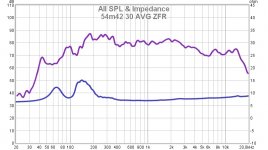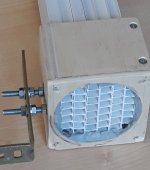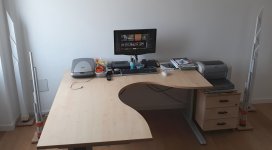I thought about the 54m42 project to confirm the answer to two questions.
With MDD technology, what changes by increasing the height of the waveguides?
It increases the response to low frequencies, in the impedance graph passing from 1 to 1.4 meters the first peak moves from 80 to 65 Hz.
What changes by increasing the number of waveguides reducing their single section?
The peaks in relation to the resonances at λ / 2 overlap, the second peak of the impedance is reduced and assumes a trend without the series of minimums and maximums.
Before proceeding to the order of other aluminum profiles I wanted to make tests with alveolar polypropylene (polionda) of 10 mm. MDD technology also works very well with plastic guides, the choice of aluminum is valid for aesthetic reasons, manual cutting over a length of 1.4 m is not regular.
On the site you can find further documentation 54m42
My site is: Claudio Gandolfi - MDD
My current working hypotheses are described on the page acustica.
The last projects reported in the full range and planars-and-exotics section:
34c9 Compact aluminum project
34c9 a MDD full range speakers.
34c9 - MDD project with aluminum pipes. Version: Compact.
66c9 66c9 a low-cost MDD project (paper waveguide for educational use)
https://www.claudiogandolfi.it/66c9.html
22D7 Two drivers per channel for a 3D effect
22D7: four MDD systems for a 3D effect with omnidirectional speakers
https://www.claudiogandolfi.it/22d7.html
22M7 Simple and inexpensive wide-band rigid PVC project.
https://www.diyaudio.com/forums/pla...nidirectional-single-drive-4.html#post6006473
other documentation is published at 22M7.
22C71L8 One driver per channel with waveguides applied to the two sides of the cone.
https://www.diyaudio.com/forums/pla...nidirectional-single-drive-5.html#post6017746
other documentation is published at 22C71L8.
MDDHX135 an MDD project with the HX135 driver
https://www.diyaudio.com/forums/pla...nidirectional-single-drive-6.html#post6124020
other documentation is published at MDDHX135.
MDD3FE25 an MDD project with the 3FE25 driver
https://www.diyaudio.com/forums/pla...nidirectional-single-drive-8.html#post6170069
other documentation is published at MDD3FE25.
With MDD technology, what changes by increasing the height of the waveguides?
It increases the response to low frequencies, in the impedance graph passing from 1 to 1.4 meters the first peak moves from 80 to 65 Hz.
What changes by increasing the number of waveguides reducing their single section?
The peaks in relation to the resonances at λ / 2 overlap, the second peak of the impedance is reduced and assumes a trend without the series of minimums and maximums.
Before proceeding to the order of other aluminum profiles I wanted to make tests with alveolar polypropylene (polionda) of 10 mm. MDD technology also works very well with plastic guides, the choice of aluminum is valid for aesthetic reasons, manual cutting over a length of 1.4 m is not regular.
On the site you can find further documentation 54m42
My site is: Claudio Gandolfi - MDD
My current working hypotheses are described on the page acustica.
The last projects reported in the full range and planars-and-exotics section:
34c9 Compact aluminum project
34c9 a MDD full range speakers.
34c9 - MDD project with aluminum pipes. Version: Compact.
66c9 66c9 a low-cost MDD project (paper waveguide for educational use)
https://www.claudiogandolfi.it/66c9.html
22D7 Two drivers per channel for a 3D effect
22D7: four MDD systems for a 3D effect with omnidirectional speakers
https://www.claudiogandolfi.it/22d7.html
22M7 Simple and inexpensive wide-band rigid PVC project.
https://www.diyaudio.com/forums/pla...nidirectional-single-drive-4.html#post6006473
other documentation is published at 22M7.
22C71L8 One driver per channel with waveguides applied to the two sides of the cone.
https://www.diyaudio.com/forums/pla...nidirectional-single-drive-5.html#post6017746
other documentation is published at 22C71L8.
MDDHX135 an MDD project with the HX135 driver
https://www.diyaudio.com/forums/pla...nidirectional-single-drive-6.html#post6124020
other documentation is published at MDDHX135.
MDD3FE25 an MDD project with the 3FE25 driver
https://www.diyaudio.com/forums/pla...nidirectional-single-drive-8.html#post6170069
other documentation is published at MDD3FE25.
Attachments
Last edited:
The MDD technology
In the previous post I talked about changes to MDD projects but I haven't described this unknown technology I've been working on for several years.
The MDD technology simulates the presence of the musical instrument in the listening room. The emission is omnidirectional, it has many secondary sonorous fronts generated in different points, delayed and consistent. The secondary sound fronts and reflections of the listening environment mask the reflections of the environment in which the recording took place. Music feels good all over the room, you can move, dance, listen or watch a movie together. The recorded sounds are always easily recognizable.
When the amplifier sends a signal, the first sound front coming to the ear is the one emitted from the back side of the speaker, the sound comes from the lower side near the floor. This primary emission is attenuated on the high frequencies.
The energy of the frontal emission is fractionated and confined in the single waveguides, it rises upwards and is re-emitted in the environment exploiting the sound diffraction with delays of 2 - 4 msec. The delayed secondary sound fronts are coherent in phase with each other because they are generated by the same speaker. Each waveguide emits all the mid and high frequencies.
At low frequencies things get complicated because a waveguide can create constructive or destructive interferences at frequencies with the wavelength of the same order of magnitude as the length of the waveguide. Things also change in view of the fact that the waveguide has one or two open sides. The waveguide lengths are calculated so that they are distributed over an octave, each low frequency always has paths available to transfer its energy into the listening environment.
As with all technologies, it is not ideal, works better or worse than others under certain conditions. Even personal tastes and habits have their influence.
My current working hypotheses are described on the page acustica.
In the previous post I talked about changes to MDD projects but I haven't described this unknown technology I've been working on for several years.
The MDD technology simulates the presence of the musical instrument in the listening room. The emission is omnidirectional, it has many secondary sonorous fronts generated in different points, delayed and consistent. The secondary sound fronts and reflections of the listening environment mask the reflections of the environment in which the recording took place. Music feels good all over the room, you can move, dance, listen or watch a movie together. The recorded sounds are always easily recognizable.
When the amplifier sends a signal, the first sound front coming to the ear is the one emitted from the back side of the speaker, the sound comes from the lower side near the floor. This primary emission is attenuated on the high frequencies.
The energy of the frontal emission is fractionated and confined in the single waveguides, it rises upwards and is re-emitted in the environment exploiting the sound diffraction with delays of 2 - 4 msec. The delayed secondary sound fronts are coherent in phase with each other because they are generated by the same speaker. Each waveguide emits all the mid and high frequencies.
At low frequencies things get complicated because a waveguide can create constructive or destructive interferences at frequencies with the wavelength of the same order of magnitude as the length of the waveguide. Things also change in view of the fact that the waveguide has one or two open sides. The waveguide lengths are calculated so that they are distributed over an octave, each low frequency always has paths available to transfer its energy into the listening environment.
As with all technologies, it is not ideal, works better or worse than others under certain conditions. Even personal tastes and habits have their influence.
My current working hypotheses are described on the page acustica.
I saw this thread and the other recently and it seems interesting.
I do hope you have a patent application pending though, or else or some grubby urchin will steal it for their own gain.
I do hope you have a patent application pending though, or else or some grubby urchin will steal it for their own gain.
I saw this thread and the other recently and it seems interesting.
I do hope you have a patent application pending though, or else or some grubby urchin will steal it for their own gain.
I applied for two European patents in 2013 and 2015. In 2018 I dropped everything and suspended payments. My development speed is too slow and too often I change projects, now in 2019 I want to do other tests with different materials and configurations. The patents had become a waste of time and money.
There is nothing to steal. It can be copied, the MDD technology is the easiest to copy in the audio field. Anyone who copies will be easily copied.
MDD: from stereo to 3D?
In MDD projects increasing the length increases the response to low frequencies but moves upwards the energy emitted by diffraction at high frequencies.
A possible solution to the problem is to use a double loudspeaker for each channel, one with short waveguides (less than a meter) and one with guides that reach beyond the two.
Before buying the material I wanted to do a test with what I had at home (52m42 + 227h) and the result is very positive. The sounds are easier to recognize, on single notes the attack and the decay are perceived, sentences and words are more easily deciphered, the number of details increases and more times I have had the impression that a song already heard lasted longer. I have not made any measures I will do on the new project, I have already purchased the material rigid PVC pipes.
I thank in advance anyone who wants to report information on similar configurations with a double pair of stereo speakers.
Link: 54m42
In MDD projects increasing the length increases the response to low frequencies but moves upwards the energy emitted by diffraction at high frequencies.
A possible solution to the problem is to use a double loudspeaker for each channel, one with short waveguides (less than a meter) and one with guides that reach beyond the two.
Before buying the material I wanted to do a test with what I had at home (52m42 + 227h) and the result is very positive. The sounds are easier to recognize, on single notes the attack and the decay are perceived, sentences and words are more easily deciphered, the number of details increases and more times I have had the impression that a song already heard lasted longer. I have not made any measures I will do on the new project, I have already purchased the material rigid PVC pipes.
I thank in advance anyone who wants to report information on similar configurations with a double pair of stereo speakers.
Link: 54m42
Attachments
In the 227h project the guides could be terminated with the profile used in the K-tubes. The K-tube made of rigid material is suitable for putting omnidirectional waves for acoustic diffraction. The sound would not change with respect to the perpendicular cut, the main characteristic of MDD projects is the delay with which coherent secondary waves are emitted. The delay is proportional to the length of the part without slots in the guide, the length then conditions the response at low frequencies.Could each wave guide be terminated with a K tube of varying lengths??
In the 52m42 project the individual guides (8 x 9 mm) are already connected to each other by an oblique profile. Adding 42 exponential profiles with dimensions of a few mm would be only a constructive complication, not detectable to listening.
- Home
- Loudspeakers
- Full Range
- 54m42 an MDD project (42 wave guides on a driver)


